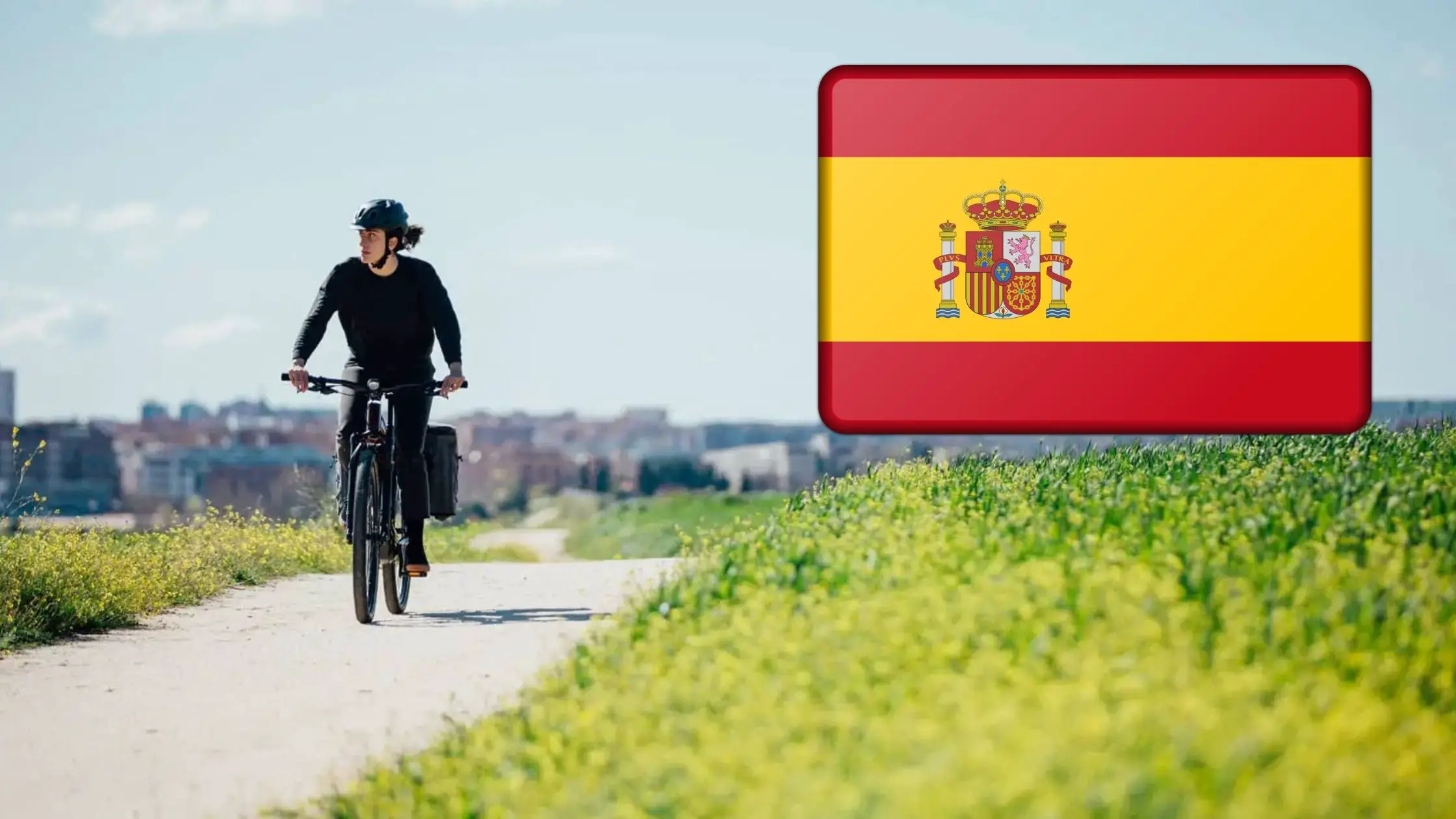Last Updated on October 22, 2023 by Igor Karni
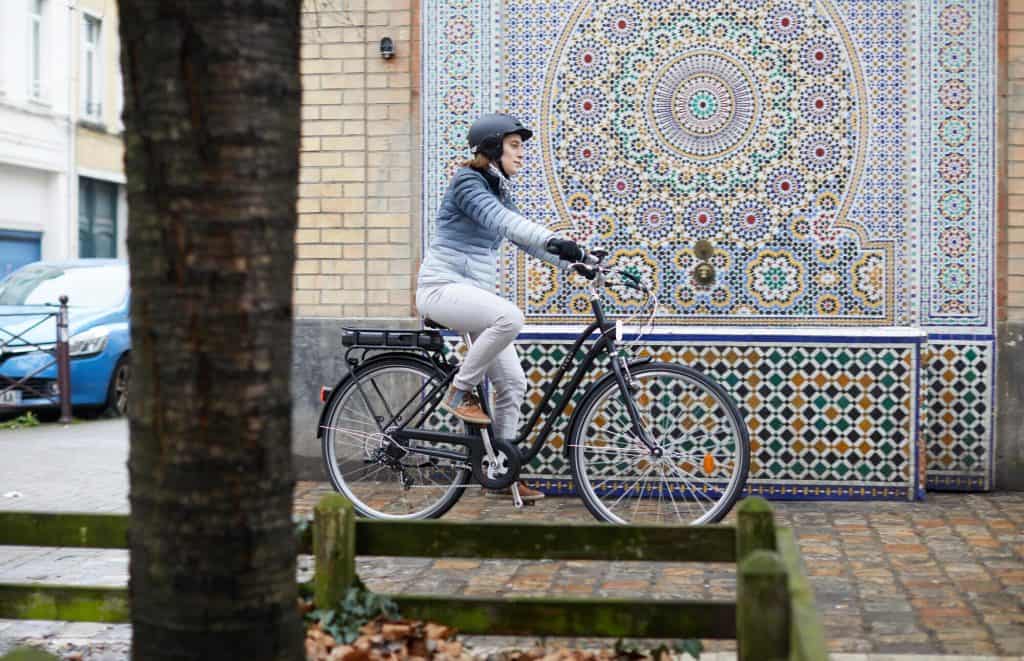
The most affordable electric bike in the Decathlons range, the Elops 120 E model is primarily intended for the city at a price of 799 euros. What’s the value of an electric bike at that price? Let’s take a closer look.
Table of Contents
Pros
- Nice design for an entry-level product
- Satisfactory comfort
- Brakes with reassuring pads
- Progressive and pleasant assistance
- All base equipment
Cons
- Rather heavy (25.9 kilos)
- Handling can be tricky
- Somewhat unnatural ride
- Bulky as very slim
- Limited autonomy and long charge
Decathlon – electric bicycles for everyone
Decathlon is a famous French brand specializing in the sale of sports equipment. The company, founded in Villeneuve-d’Ascq, near Lille, has a whole range of electric bikes with prices ranging from 799 euros to 4500 euros. Decathlon targets to attack all segments and the maximum number of potential users.
From gravel to MTBs, including cross country, folding bikes, and Dutch urban models, Decathlon is on the move. In this article, we will review the cheapest bike in the catalog: the Elops 120 E, which necessarily makes concessions to keep its price low.
Read also: Is Decathlon a good e-bike brand to buy? Brand and models review.
Unpretentious design, essential equipment
To begin this review, it is important to keep in mind an important element specific to the Elops 120 E: its price of 799 euros. We will constantly put this price into perspective when we discuss the components and equipment chosen by the company. This price point also applies to the design choices of this model.
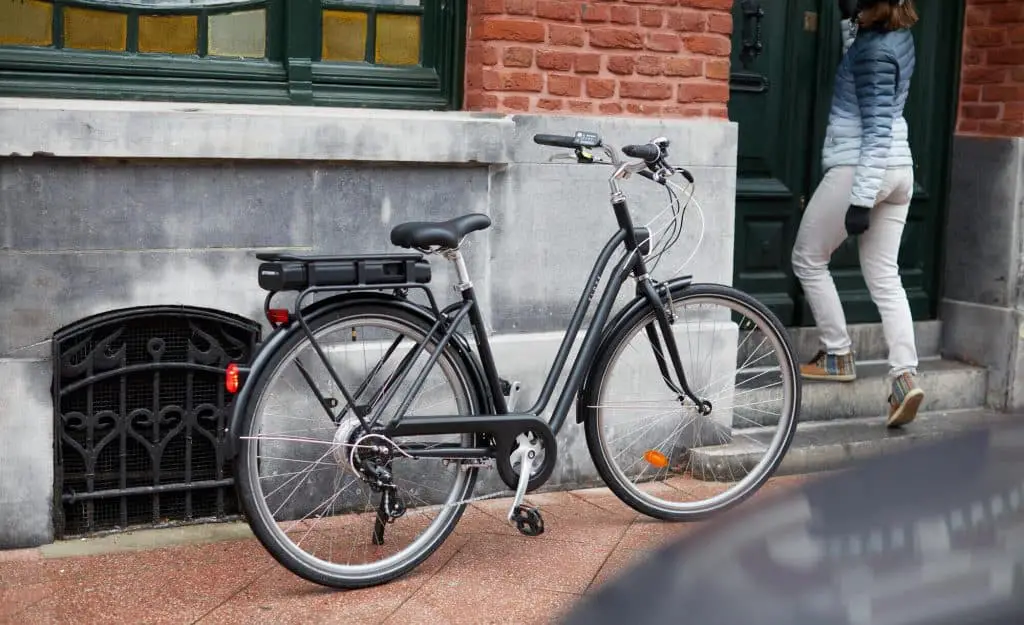
This Decathlon e-bike has no elements of a top model and goes to the essentials. The battery is installed above the luggage rack, not directly in the frame, as is often the case for more advanced models. This type of battery integration is a strong message on the segment to which the Elops 120 E belongs: the entry-level.
On the other hand, Decathlon has been smart about its choice of the e-bike frame: an open low shape, which is, therefore, suitable for a mixed audience. Getting on or off the e-bike is a breeze, whether you’re wearing jeans, shorts, suit pants, or a dress in the summer. The Elops 120 E has the merit of being practical for this kind of maneuver.
For the frame, Decathlon has opted for steel. This robust material has the advantage of providing “natural flexibility allowing it to absorb road vibrations.” On the other hand, it weighs more than aluminum, for example, and can rust over time.
The welds between the different parts of the frame are visible, but Decathlon seems to have slightly polished them to hide a bit. All in all, we’ve seen worse for much more money. As for the cables nesting in one of the tubes, it’s hard to miss them. But at this price point, not much else to be expected.
All essential equipment is in place
In terms of equipment, Elops 120 E ticks many boxes: mudguards, chain guard, aluminum kickstand, bell, as well as a luggage rack on which you can attach panniers or a baby carrier. Powered by the e-bike’s battery, the front light is integrated directly into the head tube.
This AXA light with an intensity of 20 lux. It does not claim to light up 30 meters in front of you, as the product page of the e-bike indicates, but will mainly serve to make you seen by other road users. Moreover, by being integrated into the frame, the headlight does not follow the direction of your handlebars. During a turn, the area you are supposed to be looking at is, therefore, not lit.
Good level of comfort, but be careful with stone-paved roads
Elops saddle is a nice surprise: the seat is decent on flat roads, even if we don’t recommend using it on stone-paved roads. The flexibility of the frame is not everything, and, above all, the absence of a suspended seat post does not really allow it to absorb the numerous vibrations inherent to this type of road surface.
Of course, large 28″ wheels smooth out some of the roughness, but that’s not all. We recommend you inflate the tires between 3.5 and 5 bars.
The grips with lugs do not suffer from any particular defect: your hands come to rest on them naturally for respectable comfort during a journey. As for the bell placed on the right side of the handlebar, its location is well chosen, even for small thumbs.
An intuitive on-board console
Elops 120 E is not a connected electric bike capable of pairing with a smartphone and an app. The two-wheeler only has a small onboard computer with a LED panel. The console has basic controls, which are intuitive and understandable: a power button is used to start and turn off the system, and another to change the assistance mode.
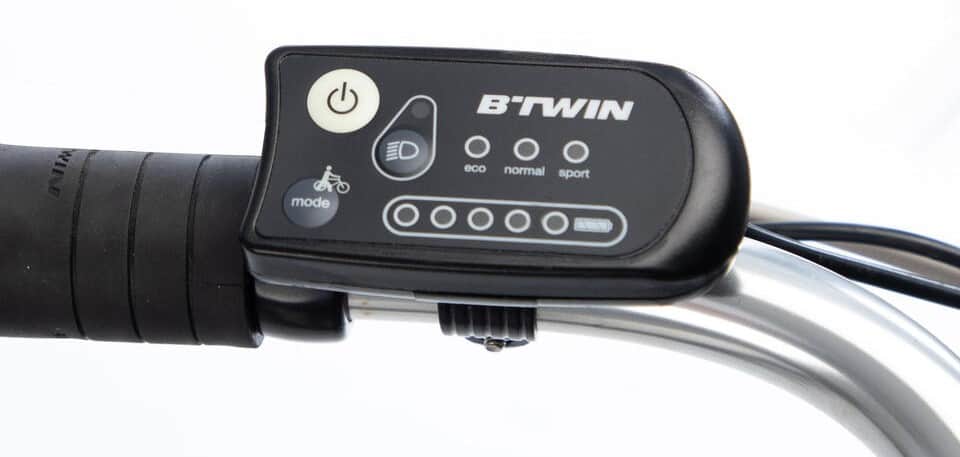
This Decathlon model offers four modes:
- Walk: assistance up to 6 km/h when you walk with the bike on a sidewalk;
- Economy: assistance up to 15 km/h ;
- Normal: assistance up to 22 km/h ;
- Sport: assistance up to 25 km/h ;
As for the autonomy, it is represented by five LED lights: the more they go out as you travel, the more the battery – and therefore your autonomy – approaches zero. A headlight button completes the picture. The headlight is activated by default when the system is switched on.
In direct sunlight, the blue LEDs are rather very difficult to see. You may need to use your hand to put a bit of shadow to see indications on the console.
A pleasant ride but not always natural
Elops 120 E is designed with city rides in mind
Decathlon Elops 120 E is not meant to venture outside the city. It is a pure urban bike, which favors an upright posture due to its Dutch-style design. Don’t look for the best speed sensations with it, nor for a sporty ride. This bike does not belong in that category.
Elops 120 E’s form also means that it doesn’t fit into cramped apartments. Its 25.9 kilos do not make it lightweight, either. Good luck carrying it up and down the stairs. Tipping it in an elevator is a possibility since the weight is mainly concentrated at the back.
If you have access to a bike room in your building or even a garden or garage to store it, this type of solution would be much better. The more adventurous can always leave it outside to stay overnight.
Read also: How to select the best city e-bike (with examples)? – also in this article, and this article. And, How much does a good city e-bike cost?
Elops 120 E uses a rotation sensor, not a torque sensor
This Decathlon model is equipped with a 250 W motor placed in the hub of the rear wheel and develops a maximum torque of 35 Nm. The e-bike uses a pedal rotation sensor and a now-more-preferred torque or pedaling force sensor. Let’s see what it means.
With a force sensor (or torque sensor), an electrically assisted bike provides you with electric assistance according to the force you put on the pedals. Your e-bicycle thus takes into account the effort provided for a more natural and pleasant ride.
With a pedal sensor, the two-wheeler releases power when a pedal rotation is detected. A slight delay between your first pedal stroke and the arrival of power is therefore felt.
For Elops 120 E, this is the case. So, in theory, and in practice, this system is less responsive to your instantaneous needs. This can be troublesome in a tricky situation where you need to react and move fast.
At a standstill, you should use low gears – which are less resistant – to get going: pedals turn faster, so the assistance arrives more quickly.

At slow speeds, this can also be a problem: if you’re in Sport mode, but you only want a tiny bit of electrically-assisted power to weave in and out of traffic, for example, then the system will deliver its full power when you make a turn of the pedals. Not so easy to understand and manage.
This situation is also true on a bike path when you follow a cyclist who is slower than you and impossible to overtake: you pedal, the bike sends all its power to propel you up to 25 km, but you have to stop pedaling to avoid hitting the rider in front.
This type of sensor also tends to consume a lot of energy since it does not adapt to the effort provided: it is all or nothing in terms of electricity assistance. On the other hand, zero effort is well and truly present when you reach 25 km/h, then pedal at speeds 2 or 3.
You may feel like you’re grinding away at your speed and gear, but since the pedals are turning, the motor is delivering electricity assistance. It’s quite fun and practical in hot weather.
Otherwise, the assistance is progressive and powerful enough to make the acceleration pleasant. On slopes, the e-bike loses a few km/h without drastically lowering its pace. Once again, for an electric bike costing 799 euros, it does the job.
Read also: Here is why e-bikes are really cool. And, How to select the best city e-bike (with examples)?
The transmission does what is expected from it
On the transmission side, Elops 120 E is equipped with a Shimano 14-28TZ500-6 cassette, a Microshift shifter, and a 6-speed B’twin Microshift derailleur. This seems to be a good and reliable combination.
Shifting gears is smooth, with no jumping between gears and no latency when shifting from one gear to another. It remains to be seen whether the reliability of this transmission will continue over the long term.
Is Decathlon Elops 120E practical in the city?
In terms of handling, there are better models. Very slim, Elops 120 E is not the easiest electric bike to handle when it comes to squeezing through relatively narrow passages. In a city with a large number of bicycle paths, Elops 120 E will be fine and will make it possible to avoid motorists most of the time.

But in other cities with not as developed cycling infrastructure, you will have to be very skillful in order to get through a line of cars, for example. Especially since, once again, the rotation sensor is not an ideal ally in this kind of situation.
Between stopped cars, a slow pace is to be preferred: to do so, you are obliged to pedal in jerks to avoid receiving 100% of the electricity assistance. Consequences: the power is not linear. Not very practical for keeping a perfect balance and maneuvering between cars. The braking option – which completely cuts off the assistance – is also a possible solution in such cases.
At higher speeds, you should not have any particular difficulty reaching your destination, taking tight turns, and overtaking other cyclists when the width of the track allows it. Elops 120 E is especially difficult to manage at lower speeds. Of course, changing riding modes is always an option, but one would like to avoid it.
Read also: Best city e-bikes for women, reviewed and compared. And, Best folding e-bikes for women, reviewed and compared.
Reassuring brakes
At 799 euros, the Elops 120 E electric bike doesn’t rely on disc brakes to help you stop, but on v-brakes. V-Brakes by Tecktro are known to be very good on dry ground. On this point, this e-bicycle is reassuring thanks to its very decent braking quality.
In wet and rainy weather, in any case, be careful and anticipate braking in advance since brake pads are known to lose their efficiency in the rain. Your wheel is wet, and the pads’ adherence to the braking zone takes more time to slow down your wheel. The pads will first have to dry the area before they can brake effectively. And, from time to time, remember to check the wear of your brake pads.
Autonomy could be better
For its Elops 120 E, Decathlon promises an autonomy of 30 kilometers with the highest level of assistance, even 60 kilometers with the lightest assistance mode. This mode propels you at a low speed of 15 km/h. These figures are based on a 70-kg cyclist on a flat course.
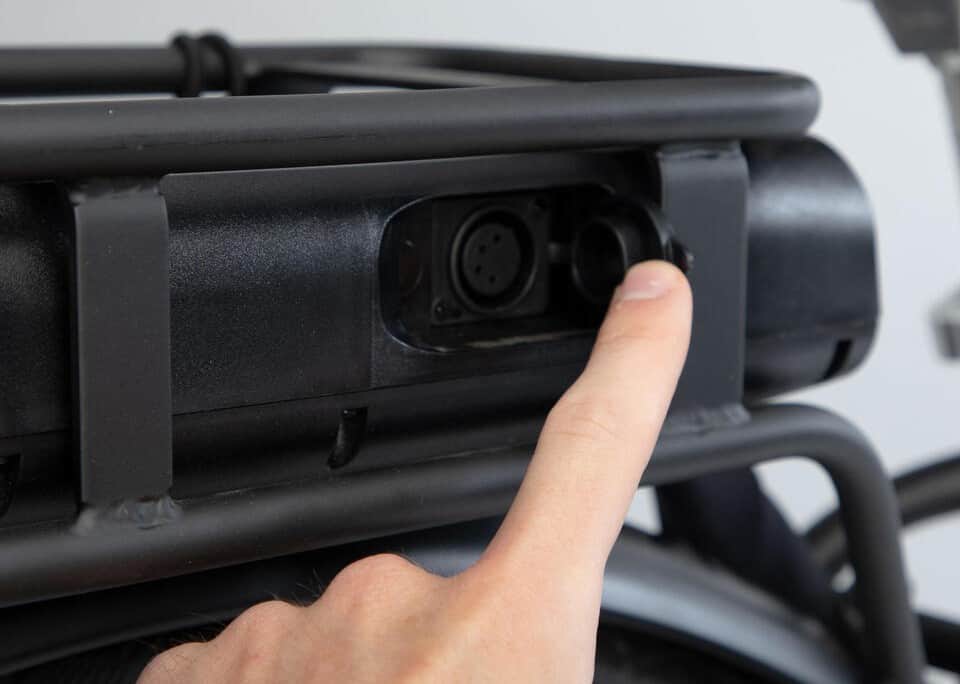
The 30 km range still seems to be too limited to enjoy an optimal rider experience. With 30 kilometers, one will have to recharge very regularly.
For example, if you ride 10 kilometers to work, then 10 kilometers back home, you will have to systematically recharge your e-bike on your way back home, at the risk of running out of fuel the next day when you return to the office. Above all, the assistance loses slightly in power (speed limited to 22 km/h) when autonomy approaches zero – at least on the last 3 or 4 kilometers. This is disappointing since you don’t even get the full 30 km.
Of course, the 799 euros required for the purchase force concessions, but Elops 120 E would have deserved at least 40 kilometers of autonomy, if not 50 kilometers, to become a small must-have. Fortunately, the battery is removable, which comes in handy since you can recharge it from just about anywhere.
If you only have 5 kilometers left when you get to work in the morning, you can just take the charger with you and plug the bike in for part of the day and be ready to go in the evening. This is a useful alternative, but it requires you to take the charger with you. To remove the battery, it is necessary to unlock it with a key to be inserted in a latch.
Running out of battery is not really an option considering the weight of the e-bike: 25.9 kilos. Finally, you should know that the battery takes about 5 hours to reach 100%. You will have to be very patient… to find only 30 kilometers of autonomy.
Read also: Cowboy 3 vs Vanmoof S3 review, top connected city e-bikes. And, Angell vs Cowboy vs Vanmoof, which one would you choose?
Price and availability of Decathlon Elops 120E
Decathlon Elops 120 E is available on the official website of Decathlon at a price of 799 euros. E-bike’s frame and fork are guaranteed for life. Other parts are guaranteed for two years “under normal use of the e-bike,” says the product sheet.
Decathlon Elops 120E datasheet
| Maximum speed | 25 km/h |
| Motor power | 250 watts |
| Number of assistance levels | 5 |
| Battery | Li-Ion |
| Announced autonomy | 60 km |
| Announced charge time | 300 min |
| Removable battery | yes |
| Bluetooth | No |
| GPS | No |
| Weight | 25.9 kg |
| Wheel diameter | 28” |
| Color | Black |
| Max riding weight | 125 kg |
| Front light | yes |
| Rear light | yes |
Final test score: 8 /10
At 799 euros, the Decathlon Elops 120 E is an electric bike that will suit most riders looking for an affordable and classic product. Don’t look for a sensation of speed and a sporty ride that goes with it, this model wasn’t designed to provide that.
Intended for the city, this e-bicycle stands out with its nice set of accessories and comfort that is quite adequate for its price.
Its entry-level transmission meets expectations and does not derail the chain. On the other hand, the choice of the rotation sensor is questionable: electric driving is less natural and pleasant than with a torque sensor. Despite v-shape brakes, the braking quality is satisfactory on dry ground.
The most disturbing drawback is autonomy. You get about 30 kilometers with the most powerful level of assistance. This is a little too limited if you use your e-bike daily, and it will force you to recharge the battery every two days, if not every day, for the most active. Its very slim shape and its weight of 25.9 kg are also to be taken into account.
Read also: Check out reviews of popular models of electric bikes.
Igor is a sustainable mobility and green energy advocate. His mission for Easy E-biking is to help make electric cycling simple, practical, and fun. Follow him on Facebook and LinkedIn.

